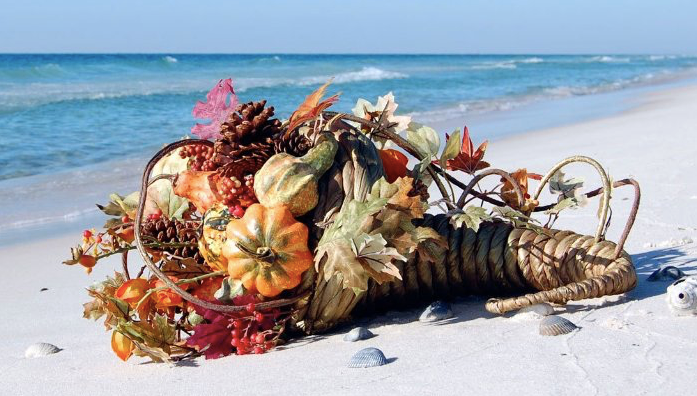Thanksgiving: Hawaiian Style! Makahiki
- By Lanai Tabura
- 12 de nov. de 2017
- 4 min de leitura

Long before the Pilgrims, native Hawaiians have celebrated "Makahiki," the longest thanksgiving in the world, which lasted four months—approximately November through February. During this time, both work and war were forbidden.
As the most important holiday of the year, Makahiki is the traditional Hawaiian celebration of the harvest and time of personal rest and spiritual and cultural renewal. It was a humbling experience. We have so much to be thankful for! We are all so fortunate to live in a beautiful environment, surrounded by sunlight, sea breezes, warm rain and inviting landscapes.
Our islands are rich and fertile from volcanic soil, and we share our ecosystem with a diverse range of flora and fauna. We have access to delicious and abundant fresh fruits and vegetables all year round.In traditional Hawaiian culture, giving thanks was an everyday affair. Giving, whether it was in the form of food, shelter, appreciation, love or aloha, was an integral part of everyone’s daily life. As we contemplate all we have to be thankful for, we also have an opportunity to consider what we can give back.
- Caitlin Rose
Hau'oli Lā Ho'omaika'i
Kalua Turkey
If you sit down at any local family’s Thanksgiving Day table, you will smell the smoky scent of kalua turkey that has been prepared in an underground oven called an imu. With Hawaiians having hundreds of years of experience cooking underground, it’s only natural that every November someone in the neighborhood will be digging an imu for the big day.
The same place we cook our pigs is where you will find us placing our turkeys for Thanksgiving.
Like anything good and worthwhile, cooking a turkey in an imu requires a lot of prep work and muscle for a great payoff. My tutu (grandmother) and tutu kane (grandfather) always prepared our turkey with Portuguese sausage, garlic, Hawaiian salt, and a few other secret ingredients. They stuffed the turkey, wrapped it in aluminum foil, placed it in a foil pan, and it was ready for the imu.
The concept of the imu is simple, but the actual work is hard and complicated. In its simplest form, it’s a hole in the ground consisting of rocks, kiawe wood, banana tree stumps, banana leaves, empty potato sacks and a lot of steam.
The end result is a moist, smoky, and “every piece ono” (delicious) turkey.
Sides
Of course the turkey is the star of the table, but we can’t forget the Hawaiian style side dishes. I’m talking about everything from macaroni salad to fried fish.
Okinawan Sweet Potatoes
In place of yams, you might find Okinawan sweet potatoes, which were introduced to us in the late 1800’s during the plantation days by the first Japanese immigrants from Okinawa.
Sausage Stuffing
Our stuffing has many different versions. Two local favorites are Portuguese sausage stuffing and lup cheong sausage stuffing. Lup cheong is a Chinese sausage and, like the Portuguese sausage, has a distinct flavor. Whether using Portuguese sausage or lup cheong, we first fry the sausage to bring out the oils. When the sausage is combined with the bread, the oil will get infused and create a unique local style stuffing. Both sausages are a big part of the local diet, and you can find them on plate lunches or in bento boxes.
Poi, Rice, and Potatoes
A Hawaiian Thanksgiving table always has poi (pounded taro mixed with water) or rice. And we are not afraid to have two or three starches, so don’t be surprised if you see mashed potatoes on the table, too.
Poke
Living on an island in the middle of the ocean, of course we always have fish. Fried, steamed, or raw, you will always find fish at any feast or gathering in Hawaiʻi. Poke (which means to cut into pieces) is probably the best supporting star on our Thanksgiving tables. There are many different kinds of poke. Grade A ahi (yellow fin tuna) cut into cubes and seasoned with soy sauce, sesame oil and limu (seaweed), is a must. Besides ahi, poke is also made with tako (Japanese for octopus) and a variety of other fish. Every Thanksgiving table will have three or four bowls of poke, each a different style.
Sashimi
As long as I can remember growing up, there was never a Thanksgiving gathering without sashimi. Next to Japan, Hawaiʻi is the capitol of raw fish consumption, so we can’t forget fresh cuts of pink ahi sashimi on Thanksgiving Day. We eat sashimi by the platter with shoyu (soy sauce) and fresh wasabi. During Thanksgiving and New Years, you will see the price of ahiskyrocket, because every household throughout the islands is feasting on fresh sashimi.
Add some island flavor to your holiday gathering with this popular recipe from Cooking Hawaiian Style.
Shiitake Lup Cheong Stuffing
A Local Thanksgiving Recipe from Cooking Hawaiian Style Prep Time: 15 | Cook Time: 45 | Ready In: 60
Ingredients
3 strip bacon, diced 4 pieces lup cheong, sliced 1/8″ 1/4 Pound ground pork 8 Ounce shiitake mushrooms, stems removed and sliced 1/8″ 1 each onion, diced 1/8″ 1/2 Cup parsley, chopped 1 Cup green onions, sliced 1 Can water chestnuts, chopped 1 bag diced stuffed bread, 13 oz. 1/4 Pound Butter 3 Cups Chicken broth salt, to taste pepper, to taste
Cooking Process:
1.In a medium sauté pan, sweat bacon, lup cheong and ground pork 2.When cooked through, add in mushrooms, onion and celery. 3.Cook for 3 minutes. 4.Add parsley, green onions and water chestnuts. 5.Add cooked ingredients (fat and all) to the bread crumbs and fold. 6.Moisten with butter and broth to taste and adjust seasoning with salt and pepper. 7.Place in oven-proof pan, cover with foil and bake at 325° for 45 minutes.
Mahalo to Cooking Hawaiian Style for this recipe.








































Comentários